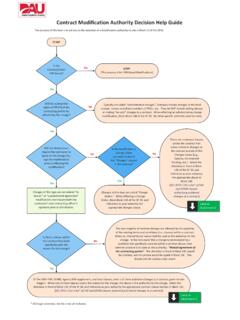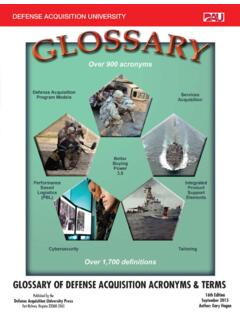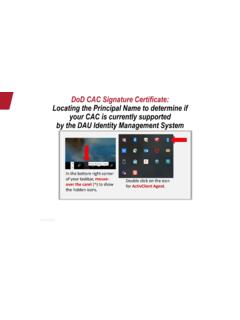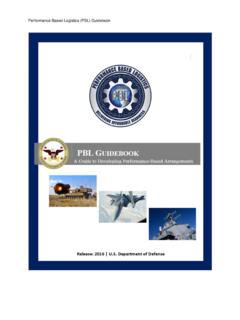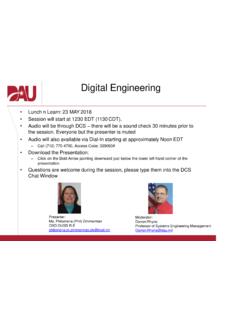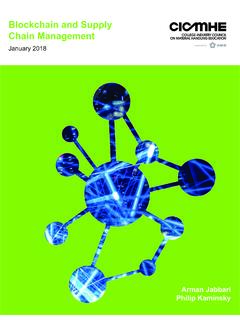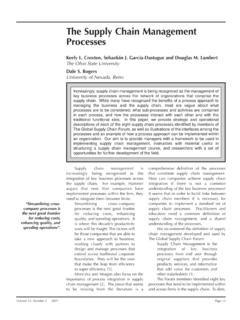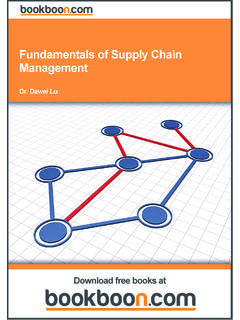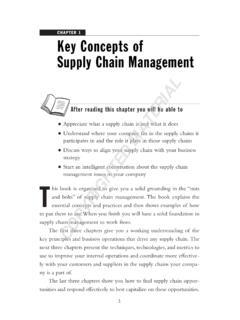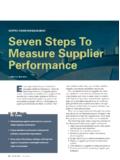Transcription of Supply Chain Risk Management - DAU
1 Supply Chain Risk Management An Introduction to the Credible Threat Heath Ferry n Van Poindexter Defense AT&L: July-August 2016 18. W. SPECIAL SECTION: RISK Management . e live in a wonderful world of instant information, and everything is connected. All we have to do is pull out our phones, tablets, laptops or any other similar device and get the information we need virtually instantaneously. While all this advanced communications technology constitutes one of the greatest things about living in a technologically advanced world, it also exposes us to one of the biggest threats.
2 How can we be sure that any and all of these devices were made to strict manufac . turing standards and weren't designed with the flaws built in or downloaded? Some of the same tools that make our lives easier also could leave us wide open to a cybersecurity breach. This article examines the elements of Supply Chain risk Management , the national security risks associated with exploitation, and the concerns for the Department of Defense (DoD). According to the November 2012 DoD Instruction (DoDI) , Supply Chain Risk Management (SCRM) is a systematic process for managing Supply Chain risk by identifying susceptibilities, vulnerabilities and threats throughout DoD's Supply Chain and developing mitigation strategies to combat those threats whether presented by the supplier, the product and its subcomponents or the Supply Chain ( , initial production, packaging, handling, storage, transport, mission operation and disposal).
3 So what does all of this mean to the government and the overall acquisition life cycle? SCRM. is a credible inside threat every bit as much as a malicious insider, counterfeiters, terrorists or industrial espionage agents. Is SCRM just a cyber issue? An intelligence issue? An acquisition issue? Honestly, it is all the same and should be treated as such. A concerted effort should be made, across all levels and domains, to address it at every step of the acquisition life cycle. The DoD, military, business and intelligence operations including communications and command and control rely heavily on trusted networked systems, devices and platforms.
4 All of these components support the ever-increasing number of capabilities that support the DoD's missions. Every component is designed, manufactured, packaged and delivered to end users, and global Supply chains provide multiple attack vectors that increase a program's cybersecurity risk. The Supply Chain is a globally distributed and interconnected web of people, processes, technology, information and resources that creates and delivers a product or service. Global Supply chains are dynamic, multilayered and complex.
5 Lack of visibility and traceability through all of the diverse layers of the Supply Chain create security challenges because each component has its own Supply Chain that provides multiple opportunities for an adversary to sabotage the raw materials, manufacturing processes, packaging and even shipping. All of these can collect information on DoD systems and lead to either industrial or traditional espionage. Ferry is one of the newest cybersecurity professors at the Defense Acquisition University (DAU) South Region in Huntsville, Alabama.
6 He currently provides Mission Assistance, curriculum development, and support to all segments of the Defense Acquisition Workforce. He holds a master's degree in cybersecurity and has multiple cybersecurity certifications. Poindexter is a professor at DAU South Region. He currently is involved in enhancing the awareness and proactive involvement of support managers and logisticians in identifying and mitigating risks in the Department of Defense Supply Chain . He is working on his doctorate in education. 19 Defense AT&L: July-August 2016.
7 The Need to Manage the Supply Chain Figure 1. The Four Aspects of Supply Everything is interconnected today, and one component in Chain Risk Management a system or network can have an impact on one system or on multiple systems at the same time. Therefore, risk must Security provides the confidentiality, integrity and be considered for each component before it is purchased or availability of information. integrated into a system. The more critical the mission, the Integrity focuses on ensuring that the products or system and the component, the more diligent we must be in services in the Supply Chain are genuine and contain managing risk.
8 Risk Management decisions require that the no unwanted functionality. decision maker consider three factors (cost, schedule and Resilience focuses on ensuring that the Supply Chain performance) and consider the impact of his or her decision provides required products and services under stress. about the desired or needed level of performance (in this case, Quality focuses on reducing unintentional vulnerabili cybersecurity) in the context of the impact of performance ties that may provide opportunities for exploitation.
9 Criteria on cost and schedule. A May 2012, Senate Armed Services Committee inquiry re . port stated that China was found to be the dominant source country for counterfeit electronic parts, a major vulnerability in the Supply Chain . The Chinese government has failed to take steps to stop counterfeiting operations, which means DoD. must step up its efforts to manage and mitigate the counter . feit threat. Unfortunately, DoD lacks knowledge of the sheer scope and impact of counterfeit parts on critical defense sys.
10 Tems. This lack of knowledge can compromise performance, reliability of defense systems and can even risk the safety of military personnel. The defense industry's reliance on unvetted independent distributors and the weaknesses in their testing regime for electronic parts creates unacceptable risks and vulnerabilities. The defense industry routinely failed to report cases of suspect counterfeit parts. This has to stop. Source: National Institute of Standards and Technology (NIST) SCRM traditionally refers to managing risks in the manufac.


